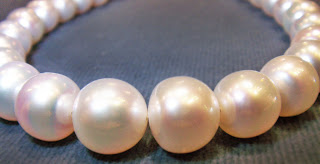South Sea pearls are produced by the
Pinctada maxima mollusk native to the seas between the northern coast of Australia and the southern coast of China. Currently cultured in areas throughout the Indian and Pacific Oceans, primarily in Indonesia, Australia, the Philippines and Myanmar. Because they grow up to 12 inches in Diameter they can be nucleated
with a much larger bead than other salt water oysters such as the akoya.
They range in size from 9mm to 20mm with the average size being 13mm, the largest on record being 24mm. They are among the largest commercially harvested pearls in the world.
Golden South Sea Pearl on
Leather Cord with Gold Beads
by Susan Drake
The color of the pearls vary depending on which oyster the pearl comes from. They are distinguished by the distinct coloration of the outer edge of
the interior. Also known as mother-of-pearl, these shells are
responsible for the coloration of the pearls they produce. There are two varieties of the
Pinctada maxima mollusk: the silver-lipped from Northern Australia which tends to produce white pearls with silver overtones and the gold-lipped which is commonly found in the sea area of south-east Asia which produces golden or creamy colored pearls.
Golden South Sea Pearls
with Sapphires by Susan Drake
There are four reasons that the South Sea pearls grow to such large sizes: the large size
Pinctada maxima mollusk, the size of the implanted bead, the length of time the pearl is left to grow in the oyster and the pyster's environment. Due to the size of the oyster it can accept a larger bead, the gonad of the
Pinctada maxima is larger enabling the oyster to deposit nacre around the nucleus at a much quicker rate, especially in warmer water which speeds the oysters metabolism. South Sea's are extremely clean, filled with plankton - the
Pinctada maxima's favorite food source. The clean waters and abundant food supply also speeds nacre production. South Sea pearls are harvested for a minimum of two years. The nacre is unusually thick from 2-6mm, compared to the 0.35-0.7mm of an akoya pearl. Their unique, satiny luster comes from the rapidly deposited nacre and warm waters of the South Seas. They come in a subtle array of colors; typically white, silver and golden, that are rare in other pearl types.
White South Sea Pearls
Culturing a good pearl is a difficult and ambivalent process. If the pearl stays in the oyster too long it will grow to be irregular, but if the pearl doesn't stay in long enough the nacre will be too thin compromising the quality of the pearl. Because South Seas pearls stay in the oyster for a long time the shape is not always perfectly round. There are few South Sea Pearls without any blemish. This makes a strand of round South Sea's pearls without blemish and with thick nacre and good luster very expensive.
Perfectly graduated round South Sea Pearl
Strand at Spectrum Art & Jewelry




